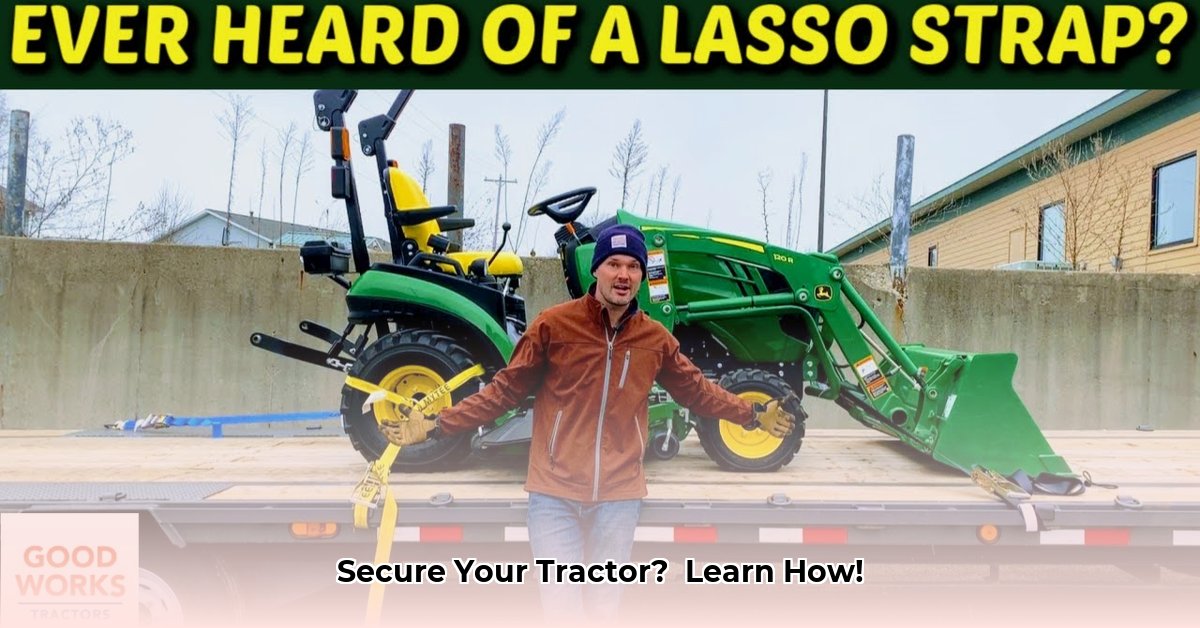
Hauling a tractor requires more than just hitching it up; safe transport demands meticulous preparation and secure tie-downs. Improperly secured tractors can cause significant damage, delays, and even accidents. This comprehensive guide provides step-by-step instructions, safety precautions, and troubleshooting tips to ensure your next tractor transport is smooth and safe. For even more detailed instructions, check out this helpful guide: Tie-Down Techniques.
Choosing the Right Trailer: A Foundation for Safe Transport
Selecting the appropriate trailer is paramount. Just as you wouldn't wear ill-fitting shoes, a mismatched trailer and tractor combination is a recipe for disaster. Measure your tractor's dimensions (length, width, height, including any attachments like a front-end loader) and compare them to trailer specifications. Ensure sufficient clearance (a few inches on all sides) to prevent overhang. Consider the trailer's weight capacity; it must significantly exceed your tractor's weight plus any implements. Heavier-duty trailers offer enhanced stability and longevity, making them a worthwhile investment for frequent transport. Did you know that a properly sized trailer can reduce transport time by up to 15%?
Selecting Tie-Down Equipment: Chains vs. Ratchet Straps
The choice between chains and ratchet straps depends on your needs and preferences, but both serve crucial roles in secure transport.
| Tie-Down Option | Advantages | Disadvantages |
|---|---|---|
| Chains | Exceptional strength, abrasion resistance, suitable for heavy loads | Potential for paint damage, cumbersome to adjust, may require specialized tools |
| Ratchet Straps | Flexibility, gentler on equipment, easier to use, less likely to cause paint damage | Lower strength limits than chains, potential for stretching or failure if overloaded |
Regardless of your choice, always verify the Working Load Limit (WLL) – the maximum weight the equipment can safely handle. Never exceed the WLL; doing so compromises safety and potentially voids any warranty. Select tie-downs with a WLL significantly exceeding your tractor's total weight. Regularly inspect your equipment for wear and tear before each use.
Step-by-Step Tie-Down Instructions: A Practical Guide
This section details the safe and effective tie-down process. Remember, patience and attention to detail are crucial.
Prepare Your Tractor: Remove any loose items from the tractor (tools, debris) that could shift during transport. This prevents potential hazards and simplifies the tie-down process.
Load the Tractor: Carefully drive your tractor onto the trailer, ensuring it's centered for optimal weight distribution. Take your time; rushing this step often leads to mistakes.
Secure the Wheels: Employ wheel chocks against the tractor's wheels to prevent rolling. This is especially vital on inclines or uneven surfaces.
Identify Tie-Down Points: Locate sturdy tie-down points on both the tractor and trailer. Use the tractor’s designated tie-down points whenever possible for optimal safety.
Attach and Secure: Attach your chosen tie-down equipment, ensuring connections are secure and free from slack.
Apply Tension: Tighten the straps or chains until snug, preventing movement without over-tightening (which can cause damage). Aim for equal tension on chains.
Comprehensive Safety Check: Before moving, thoroughly inspect all tie-downs. Are they securely fastened? Check for signs of wear or damage.
Transport Safely: Drive slowly and cautiously, avoiding harsh braking or sharp turns. Regularly check your mirrors to monitor the tractor's position.
Safety Precautions: Prioritizing Safe Transport
- Even Weight Distribution: Distribute the tractor's weight evenly across the trailer to enhance stability.
- Protect Your Paint: Use protective padding (rubber mats, blankets) to prevent damage from chains or straps.
- Regular Checks During Transport: On long journeys, take breaks to inspect tie-downs and ensure nothing has shifted. This proactive approach minimizes risks.
Post-Transport Inspection: A Final Check
Upon arrival, inspect your tractor and trailer for any damage. Addressing damage promptly prevents future problems.
Troubleshooting Common Issues
Straps Slipping: Check attachments and tighten. If the problem persists, use additional straps or stronger ones.
Chains Rattling: Tighten chains, and consider adding padding to reduce noise and vibration. Rattling indicates looseness, which is a safety concern.
Conclusion: Safe Practices for Secure Transport
Safe tractor transport is a combination of preparation, proper equipment, and careful execution. Following these guidelines will help you ensure the safe and efficient transport of your valuable equipment, minimizing risks and maximizing efficiency. Remember that a properly secured tractor is a demonstration of responsible ownership, ensuring both safety and equipment longevity.